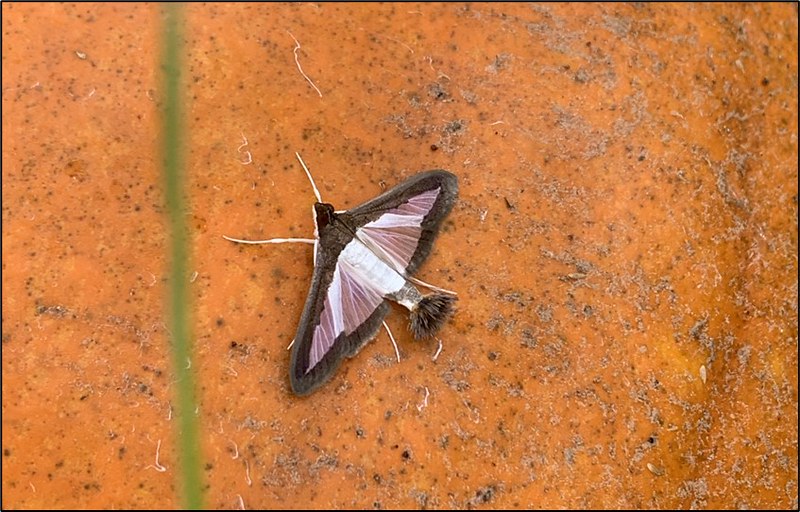By Sarah Cato
University of Arkansas System Division of Agriculture
Cooperative Extension Service
Arkansas’ future jack o’ lanterns are facing a scare of their own, with the early arrival of melonworms that can cause significant yield loss for growers.
Melonworm is a pest of cucurbit crops — a family that includes cucumbers and watermelons — that feeds on plant foliage and fruit, usually etching pumpkin rinds just under the stems, causing handles to pop off, or where the fruit contacts the ground. Often confused with pickleworm, melonworm is a different, tropical species that migrates to Arkansas from coastal regions. Because melonworm doesn’t overwinter in Arkansas, its arrival varies year to year, typically beginning in early to mid-September, but sometimes as early as late August.
“We first saw melonworm on Aug. 8 near Fort Smith and Aug.15 in Hope,” said Aaron Cato, extension horticulture integrated pest management specialist for the University of Arkansas System Division of Agriculture. “This is about a month earlier than usual. In 2021, moths showed up sometime in August and began multiplying rapidly before pumpkin harvest started, leading to widespread damage.”
Cato said many Arkansas growers saw a 50 percent or more yield loss in 2021. The early arrival of melonworm, both in 2021 and 2024, may be in part related to tropical weather.
“In 2021 Tropical Storm Claudette and Hurricane Ida had heavy winds that likely moved a lot of moths north towards Arkansas,” Cato said. “In 2022 and 2023 there was no tropical weather tracking from Texas and Louisiana in our direction, and we saw almost no impact from melonworm in those years.”
It’s possible that Hurricane Beryl, which moved into the Gulf of Mexico in early July of this year contributed to the early arrival of melonworms. Cato said with this early arrival, paired with the recent Tropical Storm Francine, growers should treat this year like 2021 and scout early and often.
“Based on observations from the past four years, melonworm arrival by early September signals a problematic year,” Cato said. “Aug. 8 is a very early sighting and growers should be on guard, as this is a similar trajectory to 2021 where many growers incurred significant loss.”
Scouting and control methods
Cato said growers should be scouting pumpkins for melonworms one to two times a week, focusing on the early signs of an infestation.
“The earliest signs of melonworm is feeding on the leaves, where melonworm larvae will be present in the new growth first,” Cato said. “It’s also important to keep an eye out for moths and rolled or folded leaves. Fruit should also be scouted for injury, even if melonworm haven’t been observed.”
Melonworm moths have white, almost translucent, wings with a brown outline. Larvae are green caterpillars with two longitudinal, white stripes down their back and four sets of prolegs.
Cato recommends an insecticide application as soon as melonworm larvae are observed in a pumpkin planting.
“We recommend growers have a diamide insecticide like Besiege, Coragen or Shenzi on hand and apply as soon as you find any melonworm larvae or moths,” he said. “If growers are already spraying a weekly pyrethroid for control of other pests they can expect melonworm to be suppressed as well. Our data indicate that weekly pyrethroids, or Bt, will suppress melonworm as well as the diamide insecticides, however, diamides offer 21 days of residual activity which has offered the least fruit loss in previous trials.”
More information on melonworm and control options can be found in Cato’s blog.
Mention of product names does not imply endorsement by the University of Arkansas System Division of Agriculture.
To learn more about Division of Agriculture research, visit the Arkansas Agricultural Experiment Station website: https://aaes.uada.edu. Follow on Twitter at @ArkAgResearch. To learn more about the Division of Agriculture, visit https://uada.edu/. Follow us on Twitter at @AgInArk. To learn about extension programs in Arkansas, contact your local Cooperative Extension Service agent or visit www.uaex.uada.edu.
About the Division of Agriculture
The University of Arkansas System Division of Agriculture’s mission is to strengthen agriculture, communities, and families by connecting trusted research to the adoption of best practices. Through the Agricultural Experiment Station and the Cooperative Extension Service, the Division of Agriculture conducts research and extension work within the nation’s historic land grant education system.
The Division of Agriculture is one of 20 entities within the University of Arkansas System. It has offices in all 75 counties in Arkansas and faculty on five system campuses.
The University of Arkansas System Division of Agriculture offers all its Extension and Research programs and services without regard to race, color, sex, gender identity, sexual orientation, national origin, religion, age, disability, marital or veteran status, genetic information, or any other legally protected status, and is an Affirmative Action/Equal Opportunity Employer.






